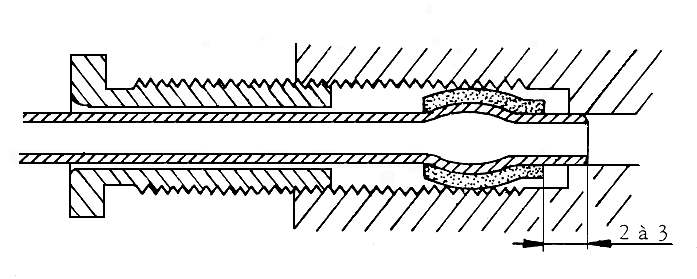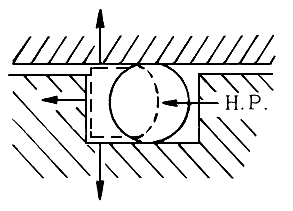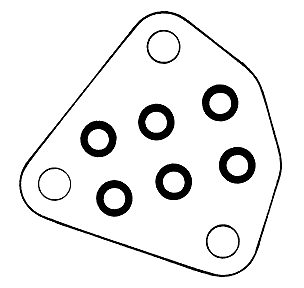To function properly, the hydraulic circuits on these cars require absolute cleanliness
of the hydraulic fluid and units.
| 1) |
Metal piping
There are two sizes of metal pipe:
|
- 4.5 mm external diameter.
- 6.35 mm external diameter.
|
- Only use standard pipes as supplied by the Spare Parts department; except for the
longitudinal pipes running the length of the chassis, all the pipes are pre-shaped ready
to be fitted.
- Pipes which have been pressure-tested are marked with a coloured sleeve, Red for LHS 2
systems, and Green for LHM. They must be used only on cars using the appropriate fluid.
- No repairs whatever may be carried out on these pipes, for reasons of safety and
reliable service (e.g. brazing, sleeving, non-standard end-fittings)
|
| 2) |
Plastic Piping
- These pipes are used for seepage returns (e.g. Suspension cylinder returns, height
corrector returns,etc.) and for petrol supply.
- It is permissible to repair these pipes by sleeving, providing that a pipe does not have
more than two sleeves which must be at least 800 mm apart. The sleeve must be glued and
when the glue has hardened the joint so made, must withstand 5 kg/cm2 (72 psi) pressure
from a compressed air line.
- The glue to be used is RILSAN cement. Sold by Etablissements BOYRIVEN, 37 bis Avenue de
Villiers - NEUILLY-SUR-SEINE.
|
| 3) |
Rubber piping
- These pipes are used for the operational returns from units, the supply from the
reservoir to the High Pressure Pump, and some seepage returns.
- All these pipes are marked Red or Green in accordance with the fluid which they are to
be used, LHS 2 or LHM respectively.
|
| 1) |
Sealing by metal clip This method of sealing is used to secure
rubber pipes onto steel and plastic pipes and unions.
When fitting:
- place a rubber protective ring under the clip.
- take care not to cut the end of the pipe.
|
| 2) |
Rubber Sleeve Seals These seals ensure the sealing of steel pipes
fitted to hydraulic units.

- Sealing is achieved by the deformation of the sleeve under the action of pressure.
- The seals must be replaced every time a pipe is disconnected.
- Do not forget to remove the old seal, then clean the bore before rebuilding.
- Always fit the seal to the pipe dry, so that about 2 mm of the pipe projects through the
seal. Centralise the pipe in the bore and ensure that the pipe goes fully home.
- The swelling near the end of the pipe holds the seal in place.
- Start the union nut by hand and tighten moderately (1 mkg) (15 ft lbs).
Seals to be used with LHS 2 are painted Red.
Those for use with LHM are Green. |
| 3) |
Ring Seals 
- Sealing is ensured by the deformation of the seal under the influence of the fluid under
pressure. In order that the pressure may achieve this, the diameter of the ring is less
than the width of the groove and greater than its depth.
- Three types of ring seals are employed:
|
- Marked Red for LHS 2
- Marked Green for LHM
- Marked White for either.
|
- Seals with White markings are only used between static components.
- The marking on a seal must always face in the direction from which the pressure is
coming. In addition the seals must be soaked in the appropriate fluid before fitting.
|
| 4) |
Sealing Plates These are found at flange joints between pipes and
units.

- When fitting, ensure that the holes in the plate correspond with those in the flange.
- The plates and the seals are sold separately.
- The seals are marked with White and are fitted to vehicles using either type of fluid.
They must be replaced at each dismantling.
|
| 5) |
Teflon Seals
- These ensure sealing of items subject to large or frequent movements (e.g. hydraulic
steering-rack piston, suspension cylinder)
- Teflon seals may be used with either type of fluid.
|
| 6) |
Identification of Seals
- Workshop sheets, available from the Spare Parts department, show clearly which seals
(Red, Green, or White), are necessary in the course of repairs or the over-haul of a
hydraulic unit.
|
| 1) |
L.H.S. 2 (FromSeptember1964 to September 1966). This fluid is
almost colourless, having a slightly amber tinge. Its smell is reminiscent of ammonia. it
must not be used on vehicles with master-cylinder braking systems, (it causes
deterioration of the rubber cups).
For Suppliers, see Technical Bulletin no. 29-D. |
| 2) |
L.H.M. (Since September 1966) This fluid is green in colour. It
is of mineral origin, and is similar to engine oil.
L.H.M. fluid is also used on N and P vehicles, and since September 1969, on AMB-3 and
AM.3 vehicles fitted with disc brakes, also,since their introduction, on the GS and SM.
For Suppliers, see Technical Bulletin no. 76-D.
NOTE : From September 1966 to December 1968, LHS 2 was still supplied in vehicles for
the U.S.A. and Canada. |
| 3) |
Contents of the systems
|
DS = 6 litres or 10.5 Imp. Pints |
|
ID = 5 litres or 8.8 Imp. Pints. |
|
The difference between Max and Min = 1 litre or 1.75 Imp. Pints. |
|
| 4) |
Draining the system The system should be drained and refilled
with fresh fluid every 30.000 km (18,000 miles).
Drain after causing the greatest possible amount of fluid to return to the reservoir.
(Suspension in low, main and brake accumulators empty). |
| 5) |
Cleaning the filter The filter must be thoroughly cleaned every
10.000 km (6.000 miles) (A clogged filter leads to inefficiency of the hydraulic system).
The filter should be cleaned in alcohol (LHS 2), and white-spirit or petrol (LHM), and
then blown through with compressed air. |
| 6) |
Advice in the event of fluids being mixed. (See Information
Bulletins nr. 32 and nr. 72). An accidental mixture of fluids in the hydraulic systems
(LHM in an LHS 2 vehicle, or vice-versa) causes a rapid deterioration of all the rubber
parts in the system (Seals, diaphragms, etc.). The severity of this deterioration is a
function of the amount of fluid mixed, and the length of time that the vehicle is operated
with this mixture.
| 1) |
In the event of a recent mixture of fluids, if there appear to be no
malfunctions of the hydraulic system, drain the system after returning as much fluid as
possible to the reservoir. Then flush the system using Hexylene-Glycol for LHS 2 vehicles,
and normal flushing oil for LHM vehicles. Check the suspension spheres, main accumulator
and brake accumulator, for pressure and verify that the diaphragms are not deteriorating.
If they are within the specified limits, refit these units. Refill the reservoir, bleed
a large amount of fluid through the braking system do not re-use the fluid bled off. Then
check the action of the suspension and the brakes. Allow the vehicle to be used for about
a week.
Check at frequent intervals that the suspension and brakes are functioning correctly.
After two weeks use, drain, refill and bleed the system again. |
| 2) |
If a vehicle has been used for a considerable time with a mixture of
fluids, malfunctions will be found in the hydraulic system. The majority of the rubber
parts will have deteriorated. Take off all the hydraulic units and change all the seals
and rubber parts. Change the main and brake accumulators, also the suspension spheres.
Flush out all the units and piping with petrol, then alcohol for LHM vehicles and with
alcohol, white-spirit or petrol and again with alcohol for vehicles using LHS 2. In both
cases, blow through with compressed air. Change all rubber pipes and dust protectors. |
|


